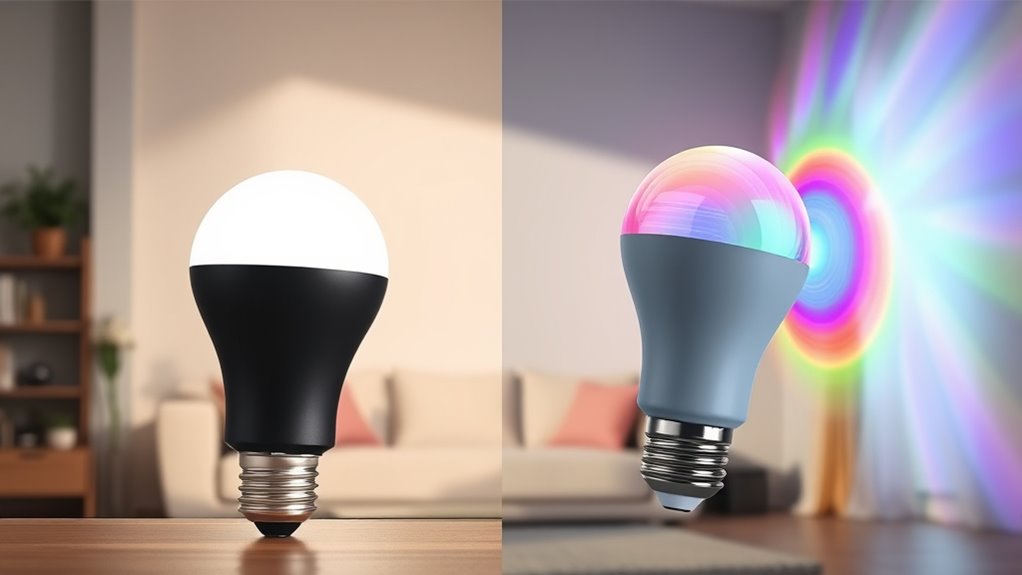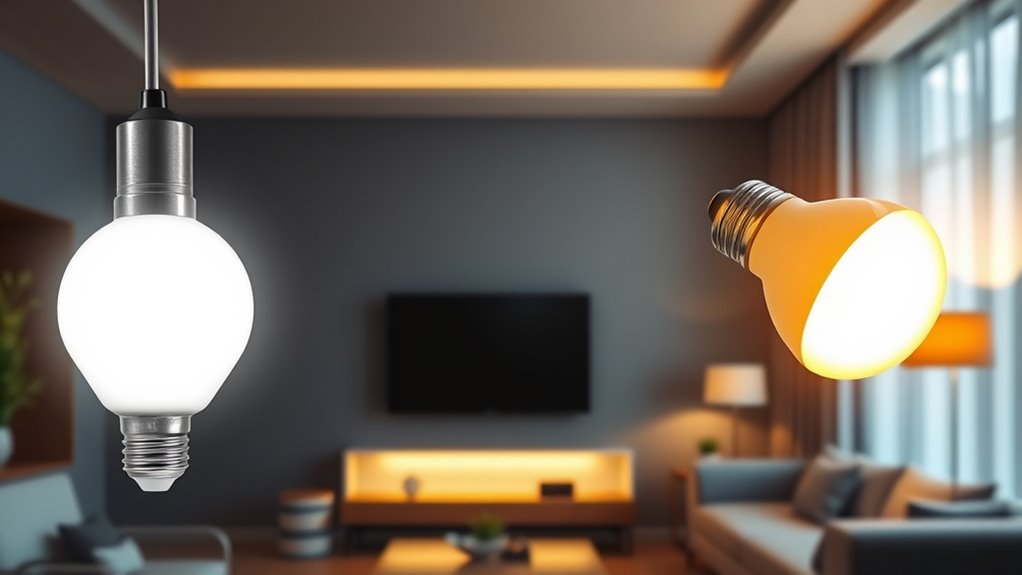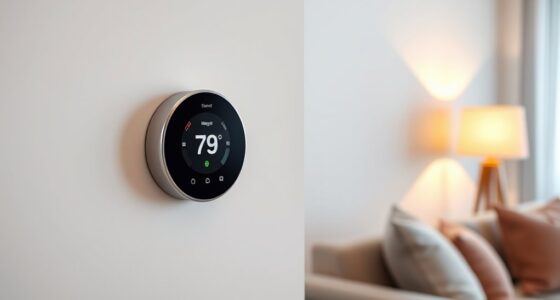Over ten years, traditional LED bulbs typically save you more money than smart bulbs because they have a lower initial cost and similar energy efficiency. Smart bulbs, with their extra features like remote control and scheduling, can add to your expenses if not managed properly. However, smart features might help reduce energy use in some cases. To discover how your habits influence savings, keep exploring the factors that affect long-term costs and benefits.
Key Takeaways
- LED bulbs are more cost-effective long-term due to lower upfront costs and similar energy efficiency compared to smart bulbs.
- Smart bulbs have higher initial prices but offer features like scheduling that can reduce energy use and save money over time.
- Both LED and smart bulbs have long lifespans (25,000–50,000 hours), decreasing replacement costs over a decade.
- Proper management of smart features can optimize energy savings, but misuse may diminish their cost benefits.
- Overall, standard LEDs typically provide greater savings over ten years unless smart bulbs are used strategically for energy optimization.

When choosing between LED and smart bulbs, understanding their differences can help you make an informed decision for your lighting needs. Both options offer advantages, but they also come with distinct features that impact your long-term costs and energy consumption. If you’re focused on energy efficiency and maximizing cost savings over a decade, it’s crucial to compare their performance closely.
LED bulbs are renowned for their high energy efficiency. They consume considerably less power than traditional incandescent or halogen bulbs, often using about 75% less energy. Over ten years, this reduction in energy use translates into noticeable savings on your electricity bills. Since LED bulbs last around 25,000 to 50,000 hours, you won’t need to replace them as often, further reducing replacement costs and maintenance efforts. Their durability means fewer trips to buy replacements, saving you both money and time in the long run. Additionally, LED bulbs are typically compatible with a variety of fixtures and settings, making them a versatile choice for different spaces.
LED bulbs save money and energy by lasting 25,000–50,000 hours and reducing electricity bills by about 75%.
Smart bulbs, on the other hand, incorporate LED technology but add features like remote control, scheduling, and color-changing capabilities. While these added functionalities are attractive, they can come at a slightly higher upfront cost. When it comes to energy efficiency, smart bulbs are comparable to standard LEDs, meaning you won’t see a dramatic difference in their energy consumption. However, their convenience features might lead some users to keep lights on longer or at higher brightness levels, which could offset some energy savings. Despite this, if you choose energy-efficient smart bulbs, you’ll still benefit from the same long-term cost savings as traditional LEDs, especially if you utilize scheduling or automation features to turn lights off when not needed.
Over a decade, your total cost savings depend heavily on how you use the bulbs. LED bulbs generally offer a more straightforward, cost-effective solution for those solely interested in saving money and reducing energy consumption. Smart bulbs, for their part, add value through customization and control, which can lead to indirect savings by optimizing usage patterns. For example, scheduling lights to turn off during daytime or when you’re away helps cut costs further. Properly managing lighting also aligns with energy-efficient lighting practices that promote sustainability and cost savings over time.
Frequently Asked Questions
How Do Smart Bulb Costs Compare Over Ten Years?
You’ll find that smart bulbs cost more upfront compared to regular LEDs, but their dimming capabilities and color options add value over ten years. With features like adjustable brightness and customizable colors, they reduce the need for additional lighting. Over a decade, smart bulbs may save you money on energy and replacements, making their higher initial price worthwhile. Plus, their convenience and versatility enhance your overall lighting experience.
Are Smart Bulbs More Energy-Efficient Than LEDS?
You might wonder if smart bulbs are more energy-efficient than LEDs. While smart bulbs often have features like adjustable color accuracy and smart bulb compatibility, they tend to use slightly more energy than traditional LEDs. However, their convenience and control options can lead to smarter energy use overall. So, if efficiency is your goal, LEDs still edge out smart bulbs, but smart bulbs offer added features that could save energy in other ways.
Do Smart Bulbs Have Higher Maintenance Costs?
Smart bulbs generally have higher maintenance costs because their bulb durability is lower, leading to more frequent replacements. You might find that they need replacing sooner than standard LED bulbs, increasing your replacement frequency. While smart bulbs offer added features, their shorter lifespan means you’ll spend more on maintenance over time. So, if you’re looking to minimize costs, consider the durability and replacement needs of your bulbs carefully.
Can Smart Bulbs Replace LED Bulbs Entirely?
You can definitely replace LED bulbs entirely with smart bulbs, provided they are compatible with your existing fixtures and home automation systems. Smart bulb compatibility varies, so check if your smart bulbs work with your preferred app or voice assistant. Also, consider LED integration options like dimming and color-changing features. If these align with your needs, smart bulbs can fully replace traditional LEDs, offering added convenience and control.
Which Bulb Type Offers Better Longevity?
When considering longevity, smart bulbs often last longer than traditional LEDs because they use advanced components designed for extended use. Plus, their dimming capabilities and color customization features help you adjust brightness and ambiance without damaging the bulb. Smart bulbs are built to endure frequent use, making them a durable choice if you want a versatile lighting solution that stays functional and vibrant over time.
Conclusion
So, which bulb truly saves more over a decade? While LEDs often come out ahead in upfront costs and energy efficiency, smart bulbs offer added convenience and features that might sway your choice. But the real question remains: will those extra perks justify the long-term savings? The numbers tell part of the story, but your priorities could tip the scale. The final decision might just be closer than you think—are you ready to find out?
Amina brings over a decade of journalism experience to her role as Editor-in-Chief. Under her leadership, Exquisite Post has flourished, maintaining the highest standards of integrity and excellence. Amina’s commitment to truth and her visionary approach guide the editorial team in producing impactful news stories that resonate with our audience.










